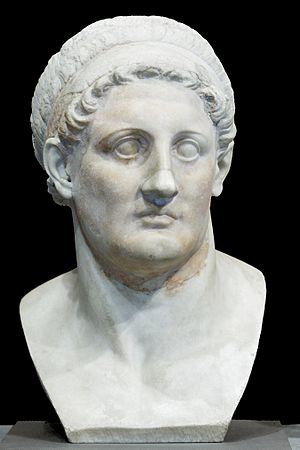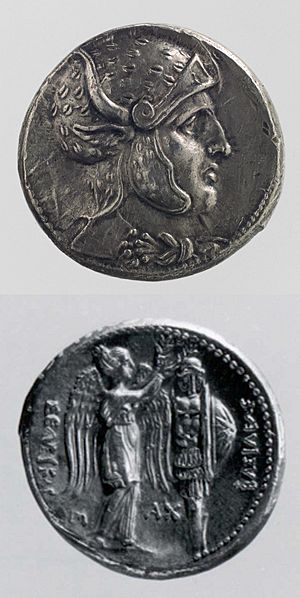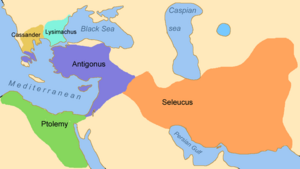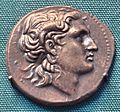Seleucus I Nicator facts for kids
Quick facts for kids Seleucus I Nicator |
|
|---|---|
| Lord of Asia King of Kings of Persia Nicator |
|

Portrait of Seleucus I Nicator, Roman artwork of the Imperial era made in a Syrian workshop after a Hellenistic model.
|
|
| Basileus of the Seleucid Empire | |
| Reign | 305 – September 281 BC |
| Predecessor | Alexander IV |
| Successor | Antiochus I Soter (co-ruler from c. 292 BC) |
| Born | c. 358 BC Europus, Macedon (modern-day Evropos, Greece) |
| Died | September 281 BC (aged c. 77) Lysimachia, Thrace (modern-day Kavakköy, Çanakkale, Turkey) |
| Spouse |
|
| Issue |
|
| Dynasty | Seleucid |
| Father | Antiochus |
| Mother | Laodice |
Seleucus I Nicator (around 358 – 281 BC) was a powerful general from ancient Macedonia. He was one of the most important "Successors" (Diadochi) of Alexander the Great. After Alexander died, Seleucus founded his own huge kingdom, the Seleucid Empire. He became the ruler of a vast area, including parts of Asia Minor, Syria, Mesopotamia, and the Iranian plateau. He even took the special title of basileus, which means "king" or "emperor." The Seleucid Empire was one of the biggest powers in the Hellenistic world for a long time.
Contents
Early Life and Family
Seleucus was the son of Antiochus and Laodice. He was born in a place called Europus in northern Macedonia. When he was a teenager, Seleucus served as a "page" for the king. This was a common way for young nobles to start their careers.
People said Seleucus was a very strong man, just like his rivals Antigonus I Monophthalmus and Demetrius I of Macedon. One story says he once stopped a wild bull with his bare hands! This might be why some coins he later made showed bull horns.
There were also legends about Seleucus, similar to those about Alexander the Great. One story claimed his real father was the god Apollo. It was said Apollo left a ring with an anchor on it for Seleucus's mother, and Seleucus even had a birthmark shaped like an anchor. This story probably helped make him seem like a natural leader, just like Alexander.
Working with Alexander the Great
Around 334 BC, when Seleucus was about 23, he joined Alexander the Great's army. He went with Alexander on his amazing journey to conquer Persia and India. Seleucus became the leader of an elite group of soldiers called the "Shield-bearers" (Hypaspistai). These soldiers were later known as the "Silvershields."
During the Battle of the Hydaspes in 326 BC, Seleucus led his troops against the war elephants of King Porus. He was always close to Alexander and his troops were ready for anything. They also fought in the Indus Valley and crossed the tough Gedrosian desert.
In 324 BC, at a big wedding ceremony in Susa, Seleucus married Apama, the daughter of a Persian leader named Spitamenes. Unlike many other Macedonian officers who later left their Persian wives, Seleucus stayed with Apama. They had a son, Antiochus I Soter, who would later become king.
Becoming a Powerful Ruler

Alexander the Great died suddenly in 323 BC without a clear heir. This led to a big power struggle among his generals, known as the Diadochi (meaning "Successors"). At first, Seleucus supported Perdiccas, who was the regent (temporary ruler) of Alexander's empire. Seleucus was given an important role as commander of the Companion cavalry.
However, Perdiccas faced problems, and his troops turned against him. Seleucus was part of a group that led to Perdiccas's assassination. After this, in 321 BC, the empire was divided again. Seleucus was given the rich province of Babylon.
But the wars among the Diadochi continued. A very powerful general named Antigonus forced Seleucus to flee Babylon. Seleucus found safety with Ptolemy, another Successor who ruled Egypt.
Return to Babylon
In 312 BC, with Ptolemy's help, Seleucus was able to return to Babylon. This moment was so important that it was later considered the official start of the Seleucid Empire and the beginning of the "Seleucid era."
Seleucus quickly expanded his control. He conquered the lands of Persia and Media. Soon, he ruled not just Babylon, but the entire eastern part of Alexander's former empire. He even claimed lands in Gandhara and eastern India.
Building an Empire
Seleucus faced a challenge from Chandragupta Maurya, the powerful emperor of the Maurya Empire in India. They fought in the Seleucid–Mauryan war (305–303 BC). In the end, they made a treaty. Seleucus gave up some eastern territories that were hard to control. In return, he received 500 war elephants! These elephants would become very important in future battles. Chandragupta also married a daughter of Seleucus, strengthening their alliance.
Seleucus also sent an ambassador named Megasthenes to Chandragupta's court in India. This helped the Greeks learn more about India.
In 306 BC, Antigonus declared himself king. Soon after, Seleucus and the other main Successors – Ptolemy, Lysimachus, and Cassander – also took the title of king. This showed they were now independent rulers of their own kingdoms.
Major Battles and Victories

The war elephants Seleucus got from India were a huge help in the Battle of Ipsus in 301 BC. In this major battle, Seleucus, Cassander, and Lysimachus teamed up to defeat Antigonus and his son Demetrius. Antigonus was killed, and his empire was divided. Seleucus gained control of Syria.
To make his empire stronger and attract more Greek settlers, Seleucus founded many new cities. He named some after himself, like Seleucia on the Tigris (which became his capital) and Seleucia Pieria. He also named cities after his parents, like Antioch on the Orontes (which became a very important city) and Laodicea in Syria. It's said he founded nine Seleucias, sixteen Antiochs, and six Laodiceas!
Seleucus made his son, Antiochus I Soter, a co-ruler of the eastern parts of the empire in 292 BC. This helped manage the vast kingdom. Antiochus later married Seleucus's second wife, Stratonice, who was also his stepmother.
Seleucus continued to expand his power. He defeated Demetrius, who had become king of Macedonia, in 286 BC. Demetrius's soldiers admired Seleucus and many joined his side. Demetrius was captured and died later.
In 281 BC, Seleucus faced his last major rival, Lysimachus, who ruled Macedonia and Asia Minor. Seleucus defeated Lysimachus at the Battle of Corupedium in Lydia. Lysimachus was killed in battle. With this victory, Seleucus was the only one of Alexander's original generals still alive and ruling a large kingdom.
Death and Legacy
After defeating Lysimachus, Seleucus controlled almost all of Alexander's former empire, except for Egypt. He planned to leave Asia to his son Antiochus and rule Macedonia and Thrace himself. However, in September 281 BC, as he entered Thrace, Seleucus was assassinated by Ptolemy Keraunos, who had sought refuge at Seleucus's court.
Seleucus's death stopped his plans to conquer Greece. His son, Antiochus I, took over as the ruler of the Seleucid Empire.
Seleucus was known as a great city founder. Many of the cities he built became important centers of Greek culture and trade. He was also seen as a liberator in some places. His legacy lived on through the Seleucid dynasty, which ruled a significant part of the Hellenistic world for many years.
Images for kids
-
Roman copy of a bronze statue of Seleucus found in Herculaneum.
-
The Hellenistic world view after Seleucus: ancient world map of Eratosthenes.
See also
 In Spanish: Seleuco I Nicátor para niños
In Spanish: Seleuco I Nicátor para niños
- Chronology of European exploration of Asia












